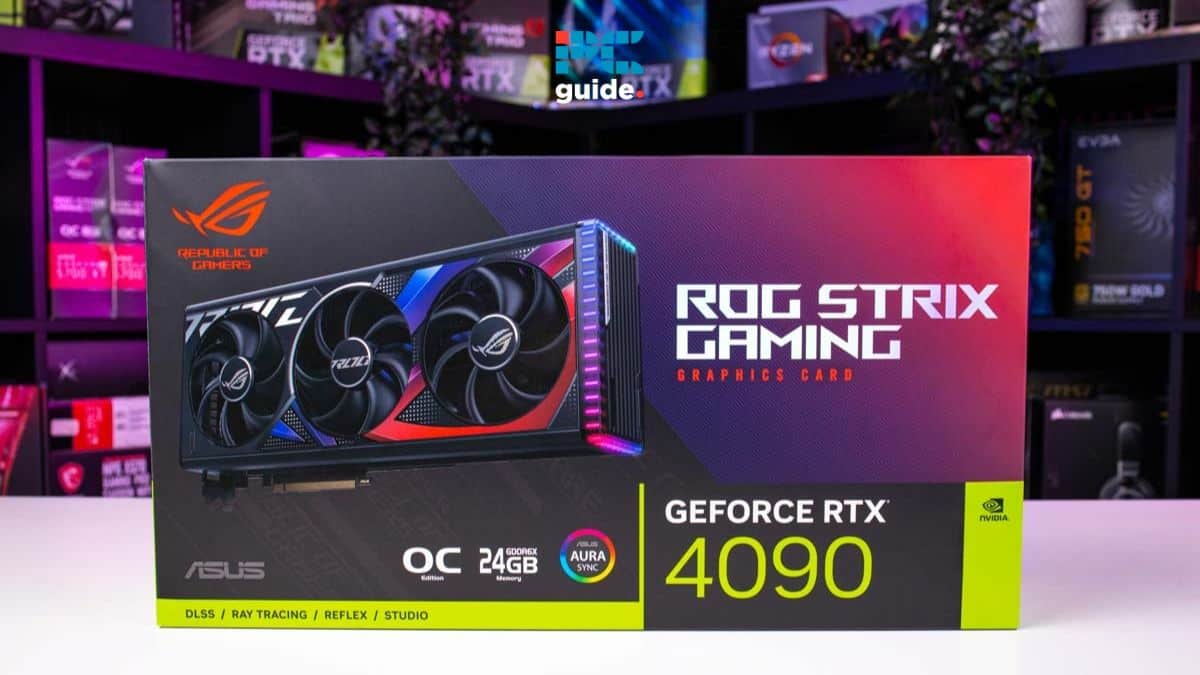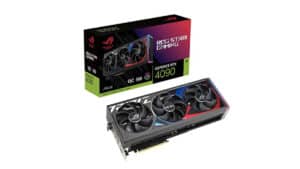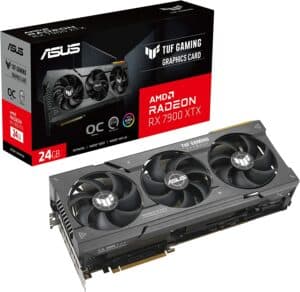Best GPU for Core i9-14900K – our top Nvidia and AMD picks

Table of Contents
If you were on the hunt for the best GPU for Core i9-14900K, you’ve come to the right place.
The Intel Core i9-14900K is the most powerful Intel chipset to date and is certainly an enthusiast pick. Choosing it for casual use is overkill, as we found in our review of the i9-14900K. So, you might think pairing it with a GPU should be straightforward because the best deserves the best, but which card do you exactly go for when both Team Red and Team Green have their lineups of top-performing cards at your disposal?
This is where we come in to help you make an informed decision. We took the liberty of doing the research for you and put together this in-depth guide that lists different cards, their details, and pros and cons. So, without wasting another moment, let’s get right to it.
Products at a Glance
How we picked the best GPU for i9-14900K
We researched the market and found various options from Nvidia and AMD. We filtered those options based on their price, compatibility, performance, and other features, such as DLSS and FSR. This gave us a list of GPUs that we think are the best to pair with an i9-14900K. We’re always updating our list with the latest information, so if there are better pairings than these, we’ll be sure to update them, so check back with us.
Product Reviews
- Excellent 4K performance
- 24GB GDDR6X RAM with 384-bit memory interface
- A solid option for future-proofing
- Comes with a very hefty price tag
- It needs a big tower casing to accommodate it
- Not very energy efficient
If you’re looking for the best GPU for i9-14900K, consider pairing it with the RTX 4090. It shouldn’t be surprising that the top GPU pick for the most powerful Intel processor is the RTX 4090, and in our review of the RTX 4090, we found that it is indeed the reigning champion of all GPUs.
For starters, this GPU has a massive 16,384 CUDA cores, a base clock of 2.32 GHz, and a boost clock of 2.52 GHz. Generally, GPUs don’t have clock speeds like 4.2 GHz, as we find on CPUs, because they focus on pulling more load than speed. That said, these speeds are pretty quick compared to other options.
On top of that, the number of CUDA cores, which are responsible for doing all the heavy lifting in parallel, are responsible for this GPU’s amazing performance in gaming and other professional tasks like video editing, rendering, machine learning, and more.
With the powerful pairing of the RTX 4090 and the Intel i9-14900K, you should also experience top-notch Ray Tracing results due to its 191 Teraflops of Ray Tracing cores. This should be great news if you prefer playing story-based games to FPS games, as they require more frames, and enabling Ray Tracing can drop those numbers.
The RTX 4090 sports 24 GB of GDDR6X memory with a whopping 384-bit memory interface. Think of the memory interface as a highway; the more lanes there are, the more cars(data) can travel on it. So, this interface should facilitate more data being able to travel at a time, which should lead to better in-game and general performance. Furthermore, 24 GB of VRAM should let you play any game with maxed-out settings without worrying about whether the GPU will run out of memory.
According to Nvidia, compared to the previous generation’s top-performing card, the RTX 3090 Ti, this GPU performs 5.2 times better with DLSS and Ray Tracing turned on in titles like Cyberpunk 2077.
However, that’s not all. With the full support of DLSS 3.5, the RTX 4090 takes the game to the next level by delivering substantial performance boosts. In titles like Cyberpunk 2077, running at 4K, you can expect to go from 20 FPS with DLSS off and RT on to a maximum of 102 FPS with DLSS and Ray Tracing on.
This GPU also utilizes a handful of Nvidia technologies, such as Nvidia Reflex, which reduces system latency. This means you can hit those snappy headshots, giving you a competitive advantage.
Lastly, this card has a length of 304 mm, a width of 137 mm, and weighs approximately 4 to 4.9 pounds or 1.8 to 2.2 kg. This means that this is a big card and you’ll need a spacious casing to accommodate it and we’ve got the top selections in our best full tower case guide. Another recommendation is to use a GPU support bracket, as this card will most likely sag due to its weight.
- Comparatively costs less than the RTX 4090
- Top-notch 4K and 1440p performance
- Strong compatibility with 2x 8pin connectors
- Requires a powerful PSU
- Despite costing less than our top pick, it still comes at a high price point
- Lack of DLSS 3.0-like feature
In our review of the RX 7900 XTX, we found that it performs exceptionally well at native 4K and at 1440p. So, it goes without saying that if you lean towards Team Red and are looking for a GPU to pair with the powerful Intel i9-14900K, the RX 7900 XTX is your card.
Let’s kick things off with some specifications. This GPU has 6,144 stream processors, a game frequency of 2,300 MHz, and a boost frequency of up to 2,500 MHz. What this means is that you can put any game in front of it, and it’ll make quick work of it with a smile on its face.
It is also designed with the latest RDNA 3 architecture, which gives it equal numbers of compute units and ray accelerators, 96 each. This means better in-game Ray Tracing and overall performance.
The RX 7900 XTX also features 24 GB of GDDR6 memory with a 384 memory interface width. This is almost the same, with the only difference being that our top pick uses GDDR6X rather than GDDR6. However, it doesn’t take away from the RX 7900 XTX’s performance, and you should be able to turn the settings to the max without worrying about overloading it.
This GPU is also compatible with a handful of technologies, such as the AMD Radeon Anti-Lag & Anti-Lag+ and Smart Access Memory (SAM). The Anti-Lag technology is AMD’s response to Nvidia Reflex. It works to control the pace of the CPU and GPU to be more in tune, resulting in reduced latency. The Anti-Lag+ works slightly differently as it applies frame alignment, resulting in better frame synchronization and even greater reduced latency.
According to AMD, you can expect a latency reduction from 45+ ms in Forspoken to 40 ms with Anti-Lag and approximately 35 ms with Anti-Lag+ turned on. This should make a huge difference in gaming and result in an overall better experience.
Regarding power consumption, the typical board power, as mentioned by AMD, is around 355W, which doesn’t put this GPU on the most energy-efficient list. However, when you have such decked-out specifications, it makes sense you need more power to keep everything fueled.
That said, the more power it consumes, the more heat it will generate. Coupled with the Intel i9-14900K, which is no stranger to running hot, you’ll need a good CPU cooler and a casing with powerful fans to keep the temperature under control and keep both components from throttling. In either case, we’ve got your back with our best CPU cooler for Intel 14th Gen and best 140mm case fans guides, which have the best pick available.
Lastly, given its native 4K performance in our review, which was without turning on FSR3, and excellent 1440p performance, this GPU is a top choice for competitive and casual gamers. This is because competitive games generally don’t require Ray Tracing or other fancy upgrades and just want the best frame rates possible. On the other hand, story-based games have beautiful scenery, which can be made more beautiful with such technologies.
Overall, given its performance and the fact that it costs less than the RTX 4090, it is one of the best GPUs for the Intel i9-14900K.
- Better performance than the RTX 4080
- Costs less than the RTX 4080
- Top-notch 2K and 4K gaming performance
- Requires a minimum of 740W PSU
- Needs a full-tower case to accommodate it
- The price point it comes at is still relatively high
If you’re looking for the best Nvidia GPU for i9-14900K and don’t want to spend a fortune on the RTX 4090, check out the RTX 4080 Super.
In our review of the RTX 4080 Super, we found that it offers better performance than its base model, a comparatively low price, and still delivers great 4K performance. It has 10,240 CUDA cores, 512 more than the base model, a base clock of 2.21 GHz, and a boost clock of 2.51 GHz. This means that this graphics card should be able to handle gaming of various types without a hitch, as it packs more than enough hardware to tackle all of them head-on.
It features 16 GB of GDDR6X memory with a 256-bit memory interface width. This means that when it comes to maxing out in-game settings, you should find that the game you play is already set to high or ultra settings due to an abundance of VRAM. This means you can enjoy various titles at high settings and not experience performance degradation due to memory constraints.
Regarding connectivity options, the RTX 4080 Super has an HDMI and three Display ports. This number of ports means that you should be able to have a multi-monitor setup. According to Nvidia, you can set up four 4K displays at 120 Hz using the HDMI or Display ports. This is great for productivity and to create a wider display if you don’t have an ultra-wide monitor.
It also supports 4K at 240Hz and 8K at 60Hz, but you might have to turn on AI upscaling to reach these levels. Furthermore, this card has the same dimensions as our top pick and is rated for a total graphics power of 320W. While this shouldn’t be surprising given the hardware it’s running, you will need to fit your case with adequate cooling solutions to keep it from running too hot. On the other hand, you can upgrade your casing with the best case for RTX 4080 Super and cut through the clutter.
The RTX 4080 Super also had 3.1 times the performance of the RTX 3080 Ti in titles like Alan Wake 2 with DLSS and Ray Tracing turned on. Nvidia also claims it is more energy efficient than the RTX 3080 Ti. However, the power draw depends on what you’re using the GPU for, and it can easily fluctuate.
Overall, this GPU offers above-average performance and should complement the performance of the Intel i9-14900K well.
How to pick the best GPU for i9-14900K
Before investing in any GPU, there are a handful of factors that you need to keep in mind. These factors should help you avoid needless upgrades and filter your options until you have the best balance between performance and value. We’ve listed some of these factors below to help you make an informed decision.
Ambient temperature and cooling
The Intel Core i9-14900K is by no means a cool processor, and if you pair it with a powerful GPU that complements its performance, you’ll have a heatwave on your hands. An additional factor is your ambient temperature, meaning the temperature of your location. If you’re in a hot region, the temperature of your CPU and GPU will peak much more quickly than in a cooler region.
In addition, our review found that the i9-14900K starts to throttle once it hits 100°C and loses 10% performance. This is less than ideal, and to avoid this from happening, you’ll have to equip your PC with adequate cooling solutions. A solid water cooler is recommended to keep the i9-14900K’s temperature in check, and for the GPU, you can upgrade your casing to one with better airflow. That said, we’ve got you covered in both scenarios with our best airflow PC case and the best AIO water cooler guides that have the top picks.
Usage and your monitor
What you plan on using the GPU for and your monitor are also important aspects to consider. If you get a high-end GPU like the RX 7900 XTX, which can handle 4K gaming but have a 1080p monitor, then the performance of such a powerful card will be wasted, and you won’t get to experience the full extent of its capabilities.
On the other hand, if you want to dabble in a little bit of 4K gaming but mainly want to play competitive shooters at 1440p with a high frame rate, then you should be fine pairing the i9-14900K with a GPU like the RTX 4080.
Check reviews
It’s always recommended that you watch review videos on YouTube and scroll through Reddit, as that can be very helpful in making a decision. Plenty of people should have the same build as you’re trying to put together or something that comes close to it. Reading up on their experience and their build’s performance should give you an insight into how your setup will perform and whether you need to tweak some components.
So, investing a little time in doing this can save you a lot of time in the future by helping you avoid needless costs and compatibility issues.
Our Verdict
Verdict
After considering the price and performance of the cards on our list offered, we concluded that the RTX 4090 is the best GPU for i9-14900K. First, it uses Nvidia’s latest technologies, such as Nvidia Reflex and DLSS 3.5. It also has 24GB of VRAM, a massive amount of CUDA cores, ground-breaking 4K performance, and future-proofs your setup for years to come. While it isn’t the most pocket-friendly option, the best of the best comes at a price, and we think it’s certainly worth it.




